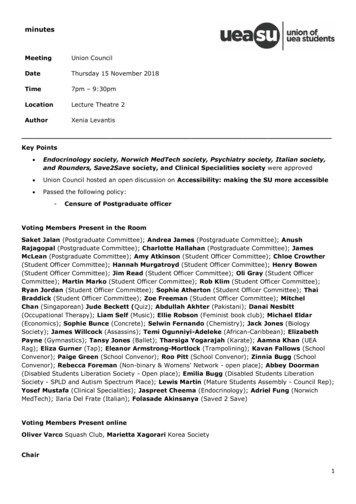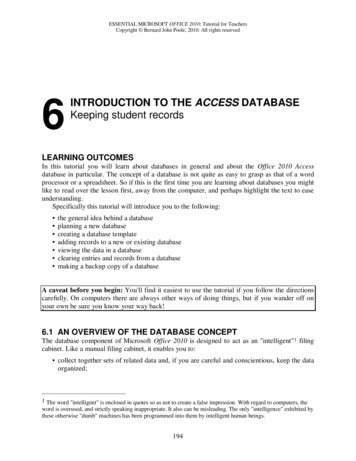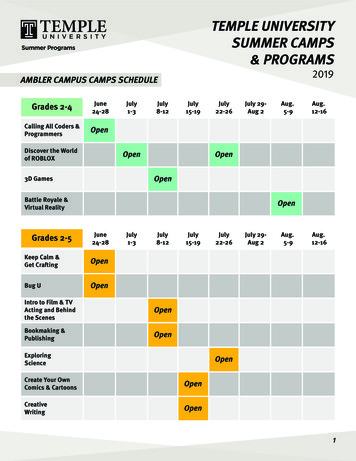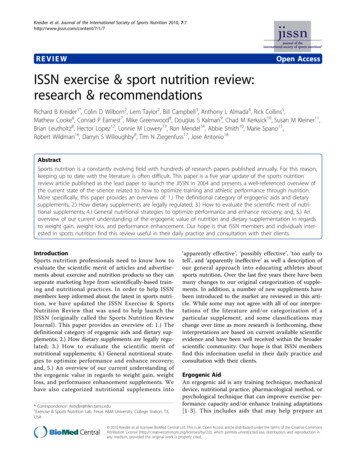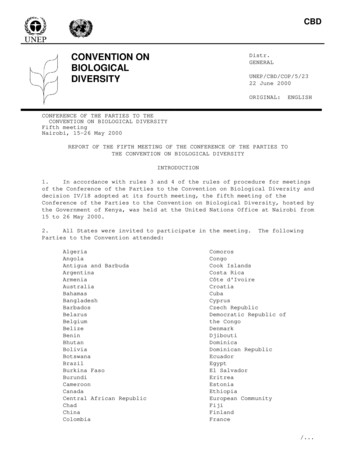
Transcription
Campbell et al. Journal of the International Society of Sports Nutrition 2013, 10:1http://www.jissn.com/content/10/1/1REVIEWOpen AccessInternational Society of Sports Nutrition positionstand: energy drinksBill Campbell1†, Colin Wilborn2†, Paul La Bounty3, Lem Taylor2†, Mike T Nelson4, Mike Greenwood5†,Tim N Ziegenfuss6, Hector L Lopez6, Jay R Hoffman7, Jeffrey R Stout7, Stephen Schmitz8†, Rick Collins9†,Doug S Kalman10, Jose Antonio11† and Richard B Kreider5*AbstractPosition Statement: The International Society of Sports Nutrition (ISSN) bases the following position stand on acritical analysis of the literature on the safety and efficacy of the use of energy drinks (ED) or energy shots (ES).The ISSN has concluded the following. 1. Although ED and ES contain a number of nutrients that are purported toaffect mental and/or physical performance, the primary ergogenic nutrients in most ED and ES appear to becarbohydrate and/or caffeine. 2. The ergogenic value of caffeine on mental and physical performance has beenwell-established but the potential additive benefits of other nutrients contained in ED and ES remains to bedetermined. 3. Consuming ED 10-60 minutes before exercise can improve mental focus, alertness, anaerobicperformance, and/or endurance performance. 4. Many ED and ES contain numerous ingredients; these products inparticular merit further study to demonstrate their safety and potential effects on physical and mental performance.5. There is some limited evidence that consumption of low-calorie ED during training and/or weight loss trials mayprovide ergogenic benefit and/or promote a small amount of additional fat loss. However, ingestion of highercalorie ED may promote weight gain if the energy intake from consumption of ED is not carefully considered aspart of the total daily energy intake. 6. Athletes should consider the impact of ingesting high glycemic loadcarbohydrates on metabolic health, blood glucose and insulin levels, as well as the effects of caffeine and otherstimulants on motor skill performance. 7. Children and adolescents should only consider use of ED or ES withparental approval after consideration of the amount of carbohydrate, caffeine, and other nutrients contained in theED or ES and a thorough understanding of the potential side effects. 8. Indiscriminant use of ED or ES, especially ifmore than one serving per day is consumed, may lead to adverse events and harmful side effects. 9. Diabetics andindividuals with pre-existing cardiovascular, metabolic, hepatorenal, and neurologic disease who are takingmedications that may be affected by high glycemic load foods, caffeine, and/or other stimulants should avoid useof ED and/or ES unless approved by their physician.IntroductionAccording to published research, energy drinks (ED) arethe most popular dietary supplement besides multivitamins in the American adolescent and young adult population [1-3]. ED are also reported to be the most popularsupplement among British athletes [4]. More recently,energy shots (ES) have also been purported to possessergogenic value on mental focus and/or performance[5]. It is important to make a distinction between ED,* Correspondence: rkreider@hlkn.tamu.edu†Equal contributors5Exercise & Sport Nutrition Lab, Department of Health & Kinesiology, TexasA&M University, College Station, Texas, TX 77843-4243, USAFull list of author information is available at the end of the articleES, and sports drinks. Sports drinks are a unique category within the beverage industry and are marketed toconsumers with the primary function of promoting hydration, replacing electrolytes and sustaining enduranceperformance capacity. They typically provide a smallamount of carbohydrate (e.g., 6-8 grams/100 ml) andelectrolytes (sodium, potassium, calcium, magnesium).ED, on the other hand, typically contain higher amountsof carbohydrate along with nutrients purported to improve perceptions of attention and/or mental alertness.Low calorie ED are also marketed to increase mentalalertness, energy metabolism, and performance. Energyshots are typically 2-4 oz. servings of concentrated fluid 2013 Campbell et al.; licensee BioMed Central Ltd. This is an Open Access article distributed under the terms of the CreativeCommons Attribution License (http://creativecommons.org/licenses/by/2.0), which permits unrestricted use, distribution, andreproduction in any medium, provided the original work is properly cited.
Campbell et al. Journal of the International Society of Sports Nutrition 2013, 10:1http://www.jissn.com/content/10/1/1containing various purported ergogens. Since ED and EScontain carbohydrate, caffeine, and/or nutrients that mayaffect mental focus and concentration, they have thepotential to affect exercise capacity and perceptions ofenergy and/or fatigue. The purpose of this position standis to critically evaluate the scientific literature and makerecommendations in regards to the role that ED and/orES may have on exercise performance and energy expenditure/metabolism. Additionally, we will discuss safetyconsiderations in regards to the use of ED and/or ES.MethodsThis analysis represents a systematic review of the literatureon the effects of “energy drinks” on exercise and cognitiveperformance as well as primary ingredients contained inpopular energy drinks. A comprehensive literature searchwas performed by searching the Medline database of theUS National Library of Medicine of the National Institutesof Health. The search strategy involved entering “energydrinks” and commercial names of energy drinks and/or caffeinated beverages as well as a search of primary nutrientscontained in popular energy drinks (e.g., caffeine, carbohydrate, taurine, glucoronolactone, Guarana, Yerba Mate,etc.). It is important to note, from a United States regulatory perspective, several of these ED are marketed as dietary supplements and not beverages, and the label on theproduct will indicate which category of Food and DrugAdministration (FDA) authority the product falls under.Each category has its own set of governing laws and regulations. For example, depending on the category, the labelswill include Supplement Facts (dietary supplements) orNutrition Facts (beverages). A paper summarizing theliterature related to ED was presented at the 2011International Society of Sports Nutrition Annual meeting.Thereafter, a position stand writing team was organized todevelop this paper. Drafts of this position stand were thenreviewed by all authors as well as the Research Committeeof the International Society of Sports Nutrition (ISSN).The final version of this paper was then adopted as theofficial position of the ISSN.Ergogenic/performance considerationsThe ingestion of nutrients prior to, during, and/or following exercise can affect exercise performance and/ortraining adaptations [6]. ED typically contain water, carbohydrates (e.g., glucose, maltodextrin), vitamins, minerals,and “proprietary blends” of various nutrients purported toincrease energy, alertness, metabolism, and/or performance (e.g., caffeine, taurine, amino acids, glucoronolactone,Guarana, Ginkgo biloba, Carnitine, Panax ginseng, GreenTea, Yerba Mate, etc.). Therefore, ingestion of ED or ESprior to, during, and/or following exercise could havesome ergogenic value. Tables 1 and 2 present a list ofingredients found in several ED/ES marketed in thePage 2 of 16United States. The next section provides an overview ofthe potential ergogenic value of some of the most commonly found nutrients in ED/ES.CaffeineCaffeine is the most common ingredient utilized inenergy drinks. Caffeine is extracted from the raw fruit ofover sixty species of coffee plants (coffea Arabica), allpart of the methylxanthine family. Caffeine is alsoextracted from tea, kola nuts, and cocoa. After ingestion,caffeine is quickly absorbed and increases in plasma concentrations are generally observed between 30 – 60 minutes following ingestion [7]. The difference in absorptiontime is dependent on the physicochemical formulationproperties of the product dose [8]. Caffeine is a strongcardiovascular stimulant that increases epinephrine output to a greater extent when ingested via its anhydrousformulation when compared to an equal amount ofbrewed or instant caffeinated coffee [9,10]. In addition,caffeine’s half-life ranges from approximately 2 to 10hours with 0.5% - 3.5% of its content excreted unchanged in urine and select amounts eliminated via perspiration [11]. A recent position stand from the Journalof the International Society of Sports Nutrition [7] summarized the effects of caffeine on exercise performanceas follows:1. Caffeine is effective for enhancing sport performancein trained athletes when consumed in low-to-moderatedosages ( 3-6 mg·kgBM-1) and overall does not resultin further enhancement in performance whenconsumed in higher dosages ( 9 mg·kgBM-1).2. Caffeine exerts a greater ergogenic effect whenconsumed in an anhydrous state as compared to coffee.3. It has been shown that caffeine can enhancevigilance during bouts of extended exhaustiveexercise, as well as periods of sustained sleepdeprivation.4. Caffeine is ergogenic for sustained maximalendurance exercise, and has been shown to be highlyeffective for time-trial performance.5. Caffeine supplementation is beneficial forhigh-intensity exercise, including team sports such assoccer and rugby, both of which are categorized byintermittent activity within a period of prolongedduration.6. The literature is equivocal when considering theeffects of caffeine supplementation on strength-powerperformance, and additional research in this area iswarranted.7. The scientific literature does not supportcaffeine-induced diuresis during exercise, or anyharmful change in fluid balance that wouldnegatively affect performance.
Campbell et al. Journal of the International Society of Sports Nutrition 2013, 10:1http://www.jissn.com/content/10/1/1Page 3 of 16Table 1 List of ingredients described on nutrient panels found in some energy ydrate 2728313230Calories from Fat---Vitamin C-100 mg-100 mg6.7mgThiamin-0.1 mg--0.2 mgRiboflavin B2 1.7 mg1.5 mg3.4 mg20%0.2 mgNiacin B320 mg21.7 mg20 mg10%2.2 mgVitamin B640 mg2.1 mg2 mg10%1.5 mgVitamin B126 mcg4.5 mcg6 mcg10%4.7 mcgPantothenicAcid-36 mg-10%1.1 mgSodium180 mg200 mg40 mg75 mg190 mgPotassium-10 mg10 mg-65 mgPhosphorus---40 mg90 mgTaurine1,000 mg600 mg1000 mg--PanaxGinseng200 mg-25--ProprietaryBlend2,500 mg L-Carnitine, Glucose,Caffeine, Guarana, Inositol,Glucuronolactone, MaltodextrinCaffeine(77 mg)325 mg Ginko Biloba (150 mg),Caffeine (80 mg), Guarana (25 mg),Inositol (25 mg), L-Carnitine (25 mg),Milk Thistle (20 mg)Guarana, maltodextrin,caffeine, taurine,panax ginseng,calciumCitrulline Malate,L-Glutamine,L-Arginine, Quercetin,L-Leucine, L-Valine,Table 2 List of ingredients described on nutrient panels found in some energy shotsIngredientABCDCalories44209E0Carbohydrate --4g1g0Calories from Fat---Vitamin C-100 mg--Niacin30 mg33 mg33 mg-126%Vitamin B640 mg40 mg40 mg-Folic Acid400 mcg400 mcg400 mcg-Vitamin B12500 mcg500 mcg500 mcg-Sodium18 mg0 mg0 mg-Potassium-10 mg10 mg-26Proprietary1,870 mg2,300 mg2,200 mg910 mg527 mgBlendTaurine,Glucuronolactone,Malic Acid,N-AcetylL-Tyrosine,L-Phenylalanine,Caffeine, CiticolineGlucouronolactone (425 mg),N-Acetyl L-Tyrosine (400 mg),L-Phenylalanine (375 mg),Taurine (350 mg),Malic Acid 300 mg),Caffeine (200 mg),Green Tea Extract (150 mg),Ginseng Extract (150 mg)Glucouronolactone (420 mg),L-Phenylalanine (380 mg),D-Ribose (350 mg),N-Acetyl L-Tyrosine (325 mg),Malic Acid (300 mg),Caffeine (175 mg),Green Tea Extract (150 mg),Ginseng Extract (100 mg)Caffeine Citrate,Caffeine Anhydrous,Evoburn,Octapomine,Gugulsterone E & Z,Yerbe Mate,Green Tea,Synephrine, cAMP,Vinpocetine,Yohimbe HCLBeta-Alanine, Vitamin C,Caffeine Anhydrous(158 mg), Trypotophan(5-HTP), Potassium,N-methyl Tyramine,Sulbutlamine,Vinpocetine,Yohimbine HCI,St. John’s Wort Extract10
Campbell et al. Journal of the International Society of Sports Nutrition 2013, 10:1http://www.jissn.com/content/10/1/1As demonstrated below, several studies have reportedsignificant improvements in both aerobic and resistanceexercise with a relative dosage of approximately 2mg·kgBM-1of caffeine. This is less than the amountrecommended (3-6 mg·kgBM-1) to enhance performance [7], and may contribute to the hypothesis that thesynergistic effects of the various ingredients containedin ED/ES are responsible for the reported improvements in exercise performance.CarbohydrateAnother common ingredient in most ED is some type ofcarbohydrate source (e.g., glucose, sucrose, maltodextrin,etc.). Energy drinks also typically contain glucuronolactone, an ingredient which is involved in ascorbic acidsynthesis and is metabolized into xylulose [12]. Evidencefrom numerous studies indicates that carbohydrate feeding during exercise of about 45 minutes or longer canimprove endurance capacity and performance [13,14].Mechanisms by which carbohydrate feeding prior toand during exercise improves endurance performanceinclude maintaining blood glucose levels, maintaininghigh levels of carbohydrate oxidation, and the sparingof liver and possibly skeletal muscle glycogen [15]. Peakrates of carbohydrate oxidation are commonly around1 g of carbohydrate per minute or 60 g·hr-1. Glucose,sucrose, maltodextrins and amylopectin are oxidized athigh rates, while fructose, galactose and amylose areoxidized at lower rates (approximately 25-50% lower)[16]. Consequently, sports drinks typically contain amixture of various types of carbohydrates designed tooptimize exogenous carbohydrate oxidation [17].ED’s contain approximately 25-30 grams of carbohydrate per 240 mL (8 fluid ounces) serving. This amountnearly meets the lower value of 30 grams/hour recommended during endurance exercise, but falls short of theupper range of 60 g·hr-1. In order to meet this upper levelof 60 grams of carbohydrate per hour during enduranceexercise, approximately 530 mL (18 fluid ounces) of atypical ED per hour would need to be consumed. Whilethe total carbohydrate content of typical ED is quite high,a shortcoming exists in regards to the concentration ofcommercially available energy drinks. The AmericanCollege of Sports Medicine [18] and the ISSN [6,17]recommend ingesting carbohydrate in a 6-8% solution(6-8 grams per 100 ml of fluid) during endurance exercise.A typical ED provides carbohydrates at a greater concentration, typically around an 11-12% solution. Ingestinghigher percentages ( 10%) of carbohydrate in fluids hasbeen reported to delay gastric emptying and increasegastrointestinal distress [19,20]. Consequently, athleteswho want to use ED as sports drinks may need to dilutethe beverage and/or alternate consumption of ED andwater during exercise.Page 4 of 16Other nutrientsTables 3, 4, and 5 present a list of additional nutrientscommonly found in ED or ES. Most ED and ES alsocontain a small amount of vitamins (e.g., thiamin, riboflavin, niacin, Vitamin B6, Vitamin B12, pantothenicacid, Vitamin C) and electrolytes (e.g., sodium, potassium, phosphorus, etc.). While the addition of thesenutrients may add to the nutrient density of theseproducts, there is little evidence that ingestion of thesevitamins and minerals in the amounts found in ED and ESwould provide any ergogenic benefit during exercise performance in well-nourished individuals [17,18]. Additionally, ED and ES typically contain nutrients purported topromote cognition and mental focus (e.g., Taurine, Ginkgobiloba, L-Tyrosine, Citocoline, 5-Hydroxy-L-Tryptophan[5-HTP], St. John’s Wort, etc.), stimulants (e.g., caffeine,Guarana, Green Tea, Synephrine, Yerba mate, Yohimbine,Tyramine, Vinpocetine, etc.), and/or various purportedergogenic nutrients (e.g., Panax Ginseng, L-Carnitine,D-Ribose, β-Alanine, Inositol, Citrulline, Quercetin, etc.).While there are data to support the potential ergogenicvalue of some of these nutrients on cognitive functionand/or exercise capacity [17,18]; the amounts found in EDand ES are generally much lower than the typical concentrations associated with an ergogenic effect. Consequently,it is unclear whether adding these nutrients to ED and/orES provides a synergistic or additive effect to the carbohydrate and caffeine found in these products. In addition,adding these nutrients to the caffeine found in ED and/orES may change the adverse effect profile of these finishedproducts, and warrant further study.Exercise performanceSeveral studies have investigated the effects of ED consumption prior to exercise. The types of exercise thatwere evaluated include resistance exercise [167,168], anaerobic exercise [169], and aerobic/endurance exercise[62,170-172].Ingestion prior to anaerobic exerciseMany of the studies investigating the effects of ED ingestion on anaerobic performance measures have beenconducted within the past several years. In a crossoverstudy (separated by seven days), Forbes and colleagues[168] gave 15 physically active college-aged students acommercially available energy drink standardized with2 mg·kgBM-1of caffeine or an isoenergetic, isovolumetric, non-caffeinated placebo 60-minutes prior toexercise. The exercise consisted of three sets of 70% onerepetition maximum (1RM) bench press conducted to failure on each set with one minute of rest between each set.Following the resistance exercise bout, three x 30-secondWingate Anaerobic Capacity tests were also conductedwith two minutes of rest between each test. The ED
Campbell et al. Journal of the International Society of Sports Nutrition 2013, 10:1http://www.jissn.com/content/10/1/1Page 5 of 16Table 3 Potential ergogenic nutrients contained in energy drinks that may affect cognition and/or mental performanceIngredientPotential ergogenic valueScientific supportTaurineImproved mental focus, concentration, serve as antioxidant,glucose homeostasis [21-24]Some supportive evidence with ED and fed animals[25-35]Gingko BilobaImprove memory and mental concentrationSome supportive evidence on memory (e.g., 120 mg/d)[36-39]. No known effects at dosages found in ED or ES.L-TyrosinePrevents depletion of catecholamines, may ameliorate declines incognition with acute stress [40-47]Some supportive evidence on cognition (e.g., 2 g/d,150 mg acute ingestion with cold exposure)[41,43,46,48,49]. No effects on performance capacity[42,50]. No known effects at dosages found in ED or ES.CiticolineIntermediate in the generation of phosphatidylcholine from choline.Increase dopamine receptor densities and delay memoryimpairment [51,52].Some supportive evidence with large doses(8.5 g prior to and during exercise) and in fed animals[52]. No known effects at dosages found in ED or ES.5-Hydroxy-LTrypotophan(5-HTP)Precursor to serotonin [53,54]. Purported antidepressant,appetite suppressant, & sleep aid [53,55-58].Some evidence in treatment of depression [53,55-58]and 5-HT fed animals on muscle performance [54,59,60].Role on exercise performance at dosages found in EDand ES is unknown.St. John’s WortAnti-depressant [56-58].Some supportive evidence [56-58]. No known effects atdosages found in ED or ES.significantly increased total bench press repetitions overthree sets (approximately 6% more repetitions completed)but had no effect on Wingate peak or average power.In a similarly designed study, a commercially availableenergy drink (providing an average of 2.1 mg of caffeineper kg of body mass) given to physically active male andfemale participants 45 minutes prior to exercise resultedin a significant increase in leg press total lifting volume(12% increase as compared to a carbohydrate placebo)but had no effect on bench press total lifting volume[167] or multiple 20-second Wingate-type cycle sprints[173]. Hoffman and colleagues [169] gave male strength/power athletes an ED containing an average of 1.8mg·kgBM-1of caffeine or a placebo beverage that wassimilar in taste and appearance but contained only inertsubstances. Following the ingestion of the ED, threeseparate 20-second Wingate tests separated by about 15minutes were performed. Results revealed that therewere no significant differences between trials in any anaerobic power measure. In a recent publication, 12healthy male and female non-resistance trained participants ingested a commercially available ED standardizedat either 1 or 3 mg·kgBM-1of caffeine or a placebo beverage (containing no caffeine) in a randomized, repeatedmeasures design [65]. Sixty minutes following beverageingestion, each participant completed 10-to-100% 1RMTable 4 Potential stimulants contained in energy drinks that may affect performance capacityIngredientPotential ergogenic valueScientific supportCaffeineStimulant. Increases metabolism and lipolysis [2,8,9,61].Increases alertness, mood, cognitive function [2,8,9,61].Increases fat oxidation, spares glycogen utilization,improves exercise [7,9-11,62-65].GuaranaNatural source of caffeine. Similar properties to caffeine.Similar to caffeine effects.Green TeaExtractContains high amounts of caffeine and catechin polyphenols(e.g., epigallocatechin gallate or EGCG). Serves as antioxidant.Similar effects as caffeine [66,67]Some supportive evidence of increased metabolism[68-76]. Specific role at dosages found in ED is unknown.SynephrineAlternative to ephedrine. Naturally derived from Citrus aurantium. Stimulantwith less cardiovascular effects than ephedrine.Purported to increase metabolism and promote weight loss.Evidence of a mild stimulant effect on metabolism andweight loss [77-82]. No known effects at dosages foundin ED.Yerba mate Contains three xanthines (caffeine, theobromine, and theophylline). Similarproperties to caffeineSimilar to caffeine effects. Some supportive evidence[83-85] No known effects at dosages found in EDand ES.YohimbineAlkaloid with stimulant and aphrodisiac properties [86-90].Similar to caffeine effects. Effects at dosages found in EDare unknown.TyramineNaturally-occurring monoamine derived from tyrosine. Acts as acatecholamine (dopamine, NE, Epi) releasing agent. Degraded to octopine.Increases blood pressure and can serve as neurotransmitter [91-93].Mild cardiovascular stimulant. Effects at dosages foundin ED / ES are unknown.Vinpocetine Alkaloid of vincamine extracted from periwinkle plant (Vinca) minor.Vasodilatory and memory enhancing properties [94,95].No known effects at dosages found in ED or ES.
Campbell et al. Journal of the International Society of Sports Nutrition 2013, 10:1http://www.jissn.com/content/10/1/1Page 6 of 16Table 5 Other potential ergogenic nutrients contained in energy drinks that may affect performanceIngredientPotential ergogenic valueScientific supportPanax GinsengContains ginsenosides which are purported to haveanti-inflammatory, antioxidant, and anticancer effects.Purported to enhance perceptions of energy, increasestamina and improve nitrogen balance [96].Most well-controlled research does not support the ergogeniceffects for ginseng [97-111]. No known effects at dosagesfound in ED and ES.L-CarnitineInvolved in shuttling long chain fatty acids intomitochondria. Purported to promote lipolysis [112].Limited supportive ergogenic value in athletes or on weightloss [112]. No known effects at dosages found in ED and ES.D-RiboseInvolved in ATP synthesis. Theoretically,D-ribose supplementation can increase ATP availability.Some evidence of improved exercise capacity in clinicalpopulations [113] but limited evidence that high dose ribosesupplementation affects exercise capacity [114-119]. Noknown effects at dosages found in ED and ES.Beta AlanineIncreases muscle carnosine levels, increases musclebuffering, and attenuates fatigue during high intensityexercise [120-124].Growing scientific evidence of improved anaerobic capacity(2-4 g/d) [125-138]. No known effects at dosages found in EDand ES.InositolCarbohydrate that is not classified as sugar. Involved ininsulin signaling, nerve transmission, serotonin modulation,and fat oxidation [139].No known effects at dosages found in ED or ES.Citrulline MalateOptimizes blood flow via arginine-nitric oxide pathway;purported to reduce fatigue and buffer acidity duringexercise [140,141].Some evidence that high dosages (e.g., 6 – 8 g) can affectexercise capacity and/or anabolism [142-149]. No knowneffects at dosages found in ED and ES.QuercetinReported to have antioxidant, anti-inflammatory, antiviral,and immune-modulatory effects [150].Several studies indicate that Quercetin supplementation(e.g., 1 g/d for 7 d) increases maximal aerobic capacity andtime to fatigue [151-166]. No known effects at dosages foundin ED or ES.power-load tests for the bench press and half-squat. Ingestion of the ED with 1 mg·kgBM-1of caffeine was notenough to raise the power output during the power-loadtests. However, the ingestion of an ED with 3 mg·kgBM-1ofcaffeine increased maximal power output by 7% in boththe half-squat and bench-press as compared to the ingestion of a placebo [65]. A recent study by Gonzalez andcolleagues [174] indicated that an energy matrix consisting of caffeine, taurine and glucoronolactone consumed10-min prior to a workout resulted in an 11.9% improvement (p 0.05) in the number of repetitions performedduring 4 sets of the squat or bench press exercise using80% of the subject’s 1-RM. In addition, the average poweroutput for the workout was significantly higher for subjects consuming the energy drink compared to subjectsconsuming the placebo.In addition to resistance and high intensity anaerobicexercise, the effects that ED exert on speed/agility performance has also been investigated. Collegiate female soccerplayers ingested an ED containing 1.3 mg·kgBM-1of caffeine and 1 gram of taurine or a caffeine and taurine-freeplacebo 60 minutes prior to repeated agility t-tests [175].No difference in agility t-test performance between the EDand placebo groups was reported. Specifically, the highestdifference reported between the two groups was duringthe third set of eight agility t-tests, and the differencereached only 1.15% between the groups. It is unlikely thatthe carbohydrate content alone in ED is responsible forimprovements in resistance exercise performance. Insupport of this view, the majority of studies in whichsupplemental carbohydrate was ingested prior to aresistance-training bout did not report improvementsin resistance training performance [176-178].ConclusionED (containing approximately 2 mg·kgBM-1caffeine) consumed 45 to 60 minutes prior to anaerobic/resistanceexercise may improve upper- and lower- body total liftingvolume, but has no effect on repeated high intensity sprintexercise, or on agility performance.Ingestion prior to endurance exerciseSeveral studies have investigated the effects of ED ingestion prior to aerobic exercise [62,170-172,179]. In theearliest of these studies, Alford and colleagues [172]investigated the effects of ingesting a commercial ED onaerobic endurance. In a repeated measures, crossoverdesign, young healthy participants ingested 250 mL of acommercial ED (containing 80 mg of caffeine and 26grams of carbohydrate), a carbonated water beverage, orno beverage at all 30 minutes prior to performing an endurance exercise bout. Test days for separate treatmentswere assessed within a week. Aerobic performance wasanalyzed by the amount of time that exercise could bemaintained at 65-75% of maximum heart rate on a cycleergometer. Significant improvements in aerobic performance were reported for the commercial ED treatment. Aerobic performance was 8% and 14% longer afteringesting the commercial ED as compared to the carbonated water and no beverage treatment, respectively.
Campbell et al. Journal of the International Society of Sports Nutrition 2013, 10:1http://www.jissn.com/content/10/1/1In one of only two studies that have investigated theeffects of ingesting a sugar/carbohydrate-free ED on performance capacity, Candow and colleagues [170] reportedno improvements in high intensity run time-to-exhaustionperformed at 80% of VO2max on a treadmill in physicallyactive college-aged participants. The sugar-free ED contained 2 mg·kgBM-1caffeine and was ingested one-hourprior to the exercise bout [170]. In contrast, Walsh andcolleagues [179] reported significant improvements intreadmill run time to exhaustion following ingestion of acarbohydrate-free ED. In this randomized cross-over investigation, 15 recreationally active participants ingested anED 10-minutes prior to engaging in a treadmill run-toexhaustion test at 70% VO2max [179]. The ED utilized inthis study did not contain any carbohydrate, and unlikeother ED products, contained nearly eight grams of theamino acids L-leucine, L-isoleucine, L-valine, L-arginineand L-glutamine. Unfortunately, the published study didnot disclose the precise amount of caffeine contained in theED, but instead referred to a 2 g “proprietary blend” ofcaffeine, taurine, and glucoronolactone. The placebo usedas a comparison was sweetened water that was similar incolor and volume. It was reported that participants consuming the ED were able to run 12.5% longer than duringthe placebo treatment [179].The two most common protocols used to assessaerobic performance are time to exhaustion at a givenexercise intensity (e.g., exercise at 70% of maximum oxygen uptake until exhaustion) and time trial performancefor a set distance (e.g., 40 km time trial). Time trialshave greater validity than time to exhaustion becausethey provide a good physiological simulation of actualperformance and correlate with actual performance[180,181]. Ivy and colleagues [62] were the first researchgroup to utilize a time trial component in conjunctionwith ED consumption. In this investigation, trained maleand female cyclists completed two trials in a repeatedmeasures crossover design separated by one week. Aftera 12 hour fast, the cyclists ingested a commercially avai
REVIEW Open Access International Society of Sports Nutrition position stand: energy drinks Bill Campbell1†, Colin Wilborn2†, Paul La Bounty3, Lem Taylor2†, Mike T Nelson4, Mike Greenwood5†, Tim N Ziegenfuss6, Hector L Lopez6, Jay R Hoffman7, Jeffrey R Stout7, Stephen Schmitz8†, Rick Collins9†, Doug S Kalman10, Jose Antonio11† and Richard B Kreider5*

